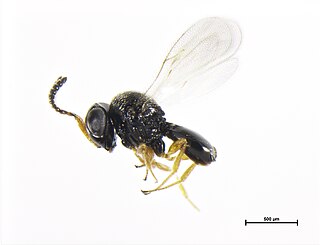
The choroid, also known as the choroidea or choroid coat, is the vascular layer of the eye, containing connective tissues, and lying between the retina and the sclera. The human choroid is thickest at the far extreme rear of the eye, while in the outlying areas it narrows to 0.1 mm. The choroid provides oxygen and nourishment to the outer layers of the retina. Along with the ciliary body and iris, the choroid forms the uveal tract.

The decidua is the modified mucosal lining of the uterus that forms in preparation for pregnancy. It is formed in a process called decidualization under the influence of progesterone. Endometrial cells become highly characteristic. The decidua forms the maternal part of the placenta and remains for the duration of the pregnancy. It is shed off during childbirth—hence why the term is used, "decidua" having the meaning of falling away, as in the word deciduous.

The basal forebrain structures are located in the forebrain to the front of and below the striatum. They include the ventral basal ganglia, nucleus basalis, diagonal band of Broca, substantia innominata, and the medial septal nucleus. These structures are important in the production of acetylcholine, which is then distributed widely throughout the brain. The basal forebrain is considered to be the major cholinergic output of the central nervous system (CNS) centred on the output of the nucleus basalis. The presence of non-cholinergic neurons projecting to the cortex have been found to act with the cholinergic neurons to dynamically modulate activity in the cortex.

Coreopsis basalis, the golden-mane coreopsis, is a North American plant species in the sunflower family. It is native to the southeastern and south-central United States from Texas to the Carolinas. Isolated populations have been reported from Connecticut, Illinois, and California.

Rhombodera basalis known as Malaysian shield mantis, is a species of praying mantis of the genus Rhombodera.

Milionia basalis is a moth of the family Geometridae first described by Francis Walker in 1854. It is found in Japan, the north-eastern parts of the Himalayas, Myanmar and Sundaland.

The nucleus basalis, also known as the nucleus basalis of Meynert or nucleus basalis magnocellularis, is a group of neurons located mainly in the substantia innominata of the basal forebrain. Most neurons of the nucleus basalis are rich in the neurotransmitter acetylcholine, and they have widespread projections to the neocortex and other brain structures.

Pterolophia is a genus of longhorn beetles of the subfamily Lamiinae, containing the following species:

Frea basalis is a species of beetle in the family Cerambycidae. It was described by Karl Jordan in 1894. It is known from Cameroon, Angola, and the Democratic Republic of the Congo.

Pterolophia melanura is a species of beetle in the family Cerambycidae. It was described by Francis Polkinghorne Pascoe in 1857. It has a wide distribution in Asia.
Pterolophia instabilis is a species of beetle in the family Cerambycidae. It was described by Per Olof Christopher Aurivillius in 1922. It is known from Seychelles.
Pterolophia guineensis is a species of beetle in the family Cerambycidae. It was described by James Thomson in 1864, originally under the genus Alyattes.
Glenea basalis is a species of beetle in the family Cerambycidae. It was described by James Thomson in 1865.
Nupserha basalis is a species of beetle in the family Cerambycidae. It was described by Wilhelm Ferdinand Erichson in 1843. It has a wide distribution in Africa.
Aradus basalis is a species of flat bug in the family Aradidae. It is found in North America.

Polymerus basalis, the red-spotted aster mirid, is a species of plant bug in the family Miridae. It is found in Central America and North America.

Marathyssa basalis, the light marathyssa, is a moth in the family Euteliidae. It is found in North America. The species was first described by Francis Walker in 1865.

Trissolcus basalis, or the green vegetable bug egg parasitoid, is a parasitoid wasp in the family Platygastridae known primarily for parasitising the horticultural pest Nezara viridula, the green vegetable bug.
Euaspis is a genus of bees belonging to the family Megachilidae.











